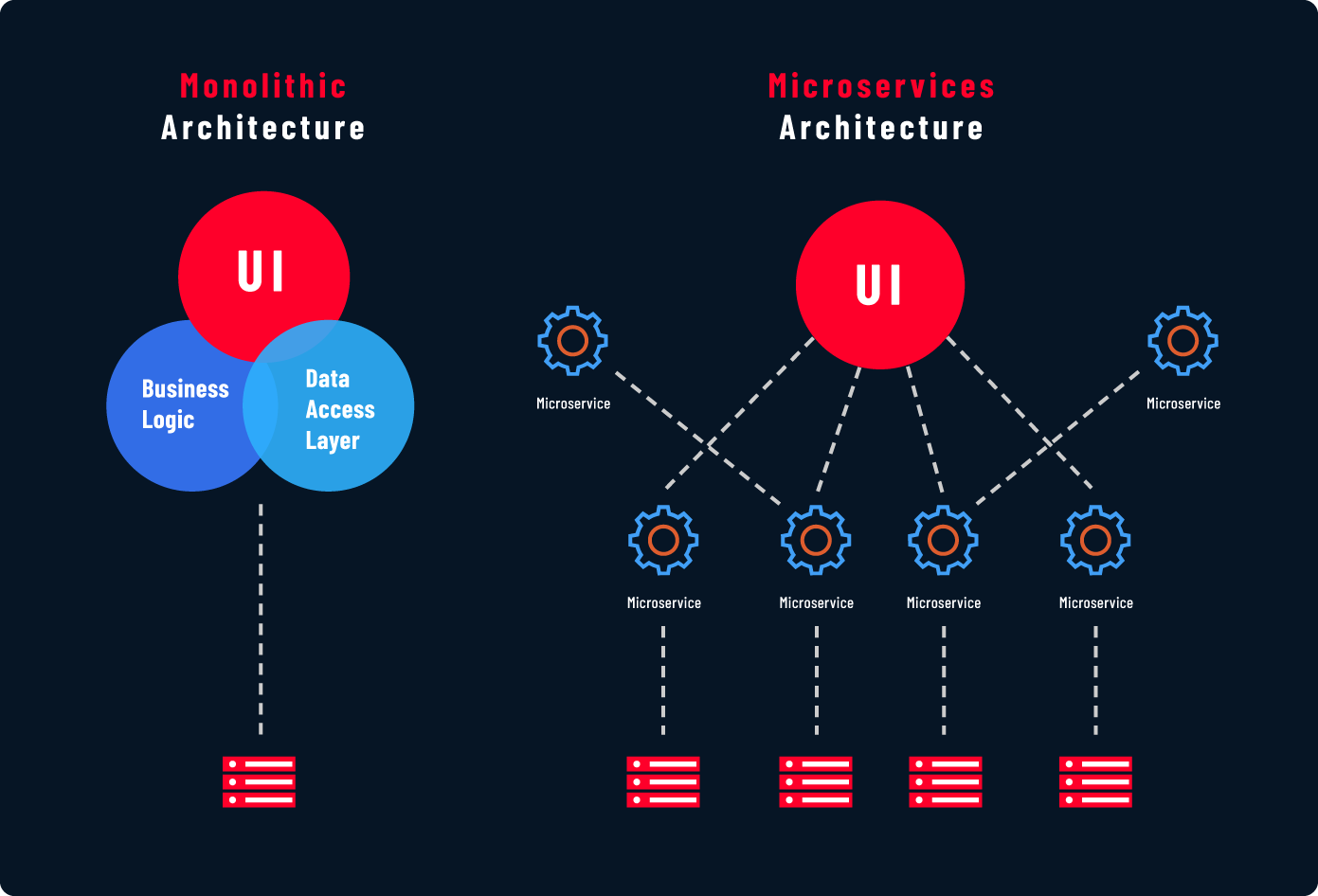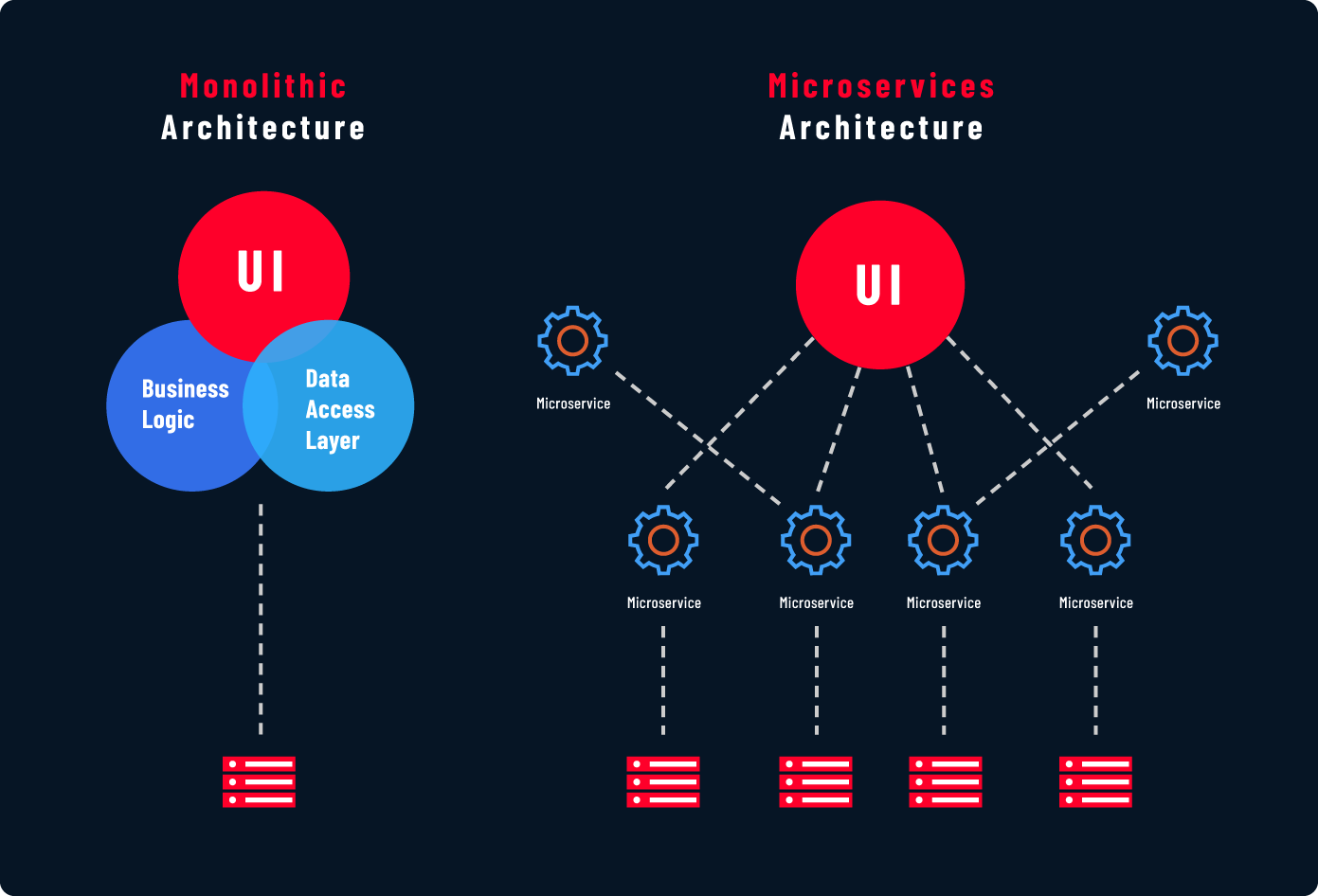
In a full Digital Transformation logic, today’s IT ecosystems are strongly inclined towards the hybrid and multi-cloud paradigm. In this context, applications implemented based on a microservices architecture can return greater advantages compared to classic monolithic software, for example in terms of resilience and acceleration of the time-to-market.
In this article, we will analyze the benefits that can be obtained by adopting the new development models, explaining when it pays off to make the switch.

The limitations of monolithic applications
Monolithic architecture is considered the traditional way of designing and developing applications. A monolithic application is built as a single, integral and indivisible unit. Typically, this type of solution includes a client-side user interface, a server-side application and a database.
In the past, the monolithic software development approach was considered the industry standard. Today, however, the adoption of this approach has seen a strong decline, inasmuch as creating a monolithic application poses a number of challenges. Some of the key ones include the need to manage a huge codebase, the lack of flexibility when it comes to quickly adopting new technologies, scalability, delivery and implementing new changes.
With the monolithic approach, modifying or adding functionality, in fact, means introducing changes that affect the behavior of the entire application, with the risk of compromising its operation in case of problems. Any coding changes affect the entire system, so these must be carefully coordinated and tested. This means that the overall development process is much longer.
The monolithic model also penalizes the speed with which releases can be put out: making a change means re-deploying the entire application. Consequently, in terms of scalability, it is not possible to size the resources in relation to the single pieces of functionality. Instead, it becomes necessary to size the entire infrastructure on which the application resides, with obvious waste in terms of costs and resources.
Microservices-based Cloud Native development
Thanks to its modular approach, a microservices architecture makes it possible to overcome the typical limitations of monolithic development. Each application is built by aggregating independent functional units. These units communicate through APIs and can be modified individually, without interfering with the overall structure and operation of the software.
In short, the microservice architectural style is an approach to developing a single application as a suite of small services, each running in its own process and communicating with lightweight mechanisms, often an HTTP resource API.
Martin Fowler
The microservices development model can help maximize performance when integrated in a Cloud Native design, with the use of containerization techniques..
Containers are virtual instances of a full runtime environment, which host the program or microservice and allow it to run independently of the underlying infrastructure. Thanks to this approach, it becomes possible to easily decouple hardware and software components, guaranteeing full portability of applications across different systems (on-premise and in the cloud).
Moreover, containerization facilitates an effective segregation of duties, with developers able to concentrate on business logic and application dependencies, while operations teams can focus on deployment and management. This, in turn, means that the operations teams don’t have to worry about application details, such as software versions and application-specific configurations.
Containers can be managed dynamically through orchestration platforms such as Kubernetes, designed to help automate processes and effectively optimize the use of resources.
Microservices: the key advantages
There are many advantages that can be obtained from the adoption of a microservices-based architecture, most of which are well-known in the industry. According to a recent Kong survey, 84% of US companies already use microservices for application development and 89% of IT managers interviewed believe that the transition to this new architectural model gives them a competitive edge in the future.
Today's pioneers of microservices include leading multinationals such as Netflix, Amazon and Uber – but rest assured, even smaller companies can reap important benefits from the adoption of this modular architectural model.
The first advantage to emphasize is the ability to scale and deploy the single piece of functionality on different environments, regardless of the application and of the other services present.
One of the immediate effects of this approach includes a reduced architectural complexity, as the application is decomposed into a series of independent services that become much faster to develop, understand, support and maintain.
The use of microservices also leads to a faster and more effective development process, as well as the acceleration of the time-to-market of the application. This, because development teams can work simultaneously and release independently. To maximize and accelerate returns, the development teams are generally small, highly performing and specialized on individual parts of the application: expertise and commitment are, in fact, the keys to obtaining even faster results.
Another important benefit of microservices is resilience: this means that if an application component is defective or corrupt, the disruption will not affect the operation of the entire application or of other services. The operational continuity of the system is thus preserved, while the IT team can focus on correcting the error on the compromised functionality. The independent nature of microservices, therefore, allows for the acceleration of debugging and maintenance activities, reducing the risk of any interventions and simplifying operation.
Finally, a microservices design favors the adoption of DevOps: a set of practices that provide for the close collaboration between Developers and Operations in the development process and, in particular, the achievement of Continuous Integration and Continuous Delivery objectives. In this scenario, new code is first tested and subsequently distributed based on important continuity and automation criteria, in turn guaranteeing a high frequency of releases.
When does it make sense to adopt microservices?
The opportunities and benefits offered by a microservices-based architecture are highly relevant. However, the monolithic approach should not always be dismissed. Let’s try to understand why.
If your goal is to release a new application or an MVP (Minimum Viable Product) in the shortest time possible, in order to collect feedback from the market and validate your business idea, the monolithic approach is certainly faster and cheaper. In particular, for small startups with a modest development team, the monolithic approach makes it possible to achieve this result quickly and efficiently.
When it comes to very simple applications that don’t integrate advanced business logic and don’t necessitate advanced scalability or flexibility, this approach once again can still prove to be a good option.
Experience in microservices design and in related topics, such as DevOps or tools such as Kubernetes, is a key criterion to take into consideration when selecting your application development approach. Moreover, it is important to remember that the adoption and use of microservices require specialized and extensive knowledge, know-how, and experience to deliver the desired benefits.
If you are faced with a lack of experience and/or competent resources in your company, it is a good idea to consider the use of a specialized partner who has already designed microservices-based architectures, in order to ensure that the best practices of this approach are adopted.
It will thus be possible to create software capable of evolving rapidly, of being flexible and which, in turn, will allow you to respond to market changes with utmost speed and agility. Today, software is at the heart of any business, representing the critical success factor for the modern enterprise.
- Previous Post
- See all posts
- Next Post